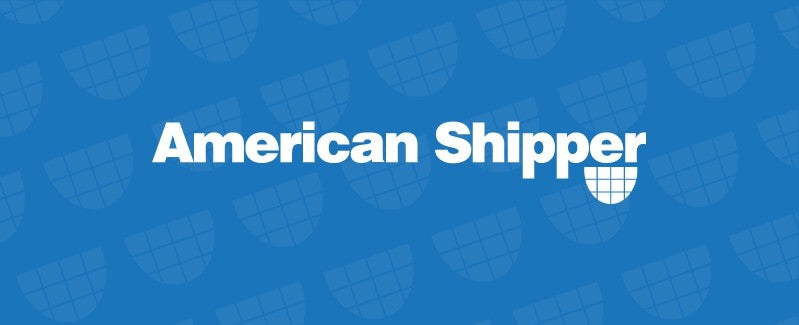Dutch-affiliate Streamlines will operate a weekly container service connecting the new GT USA terminal at the Central Florida port with Europe and Central America.
Gulftainer USA has secured the first customer for Port Canaveral’s new container terminal after a six-month wait.
Streamlines, N.V., part of the Dutch Seatrade Group, will call the Central Florida port as part of the new Blue Stream weekly container service that connects Northern Europe, the French West Indies and Central America, GT USA announced Wednesday.
Port Canaveral inaugurated its first dedicated container terminal last June. GT USA, the U.S. division of United Arab Emirates based Gulftainer, won a concession to operate the 20-acre facility for up to 35 years and has committed to invest $100 million in infrastructure, equipment and personnel. The Canaveral port authority bought two used post-Panamax cranes from the Georgia Ports Authority for $25,000 apiece to get started, but until now had not signed up any ocean carriers to use the facility.
Port and terminal officials claim Canaveral offers several advantages for Florida shippers. It is located midway between Jacksonville and Miami on the East Coast near the huge Orlando consumer market, which swells every year with tens of millions of tourists visiting area theme parks.
In addition, Canaveral is the world’s second largest cruise port, serving vessels that need to be provisioned for a week at sea. The port’s proximity to consumers as well as scores of distribution centers in Central Florida means importers and exporters can save time and money compared to trucking cargo further to and from ports such as Charleston, Savannah or Norfolk.
Port Canaveral is also less than an hour from the pilot buoy to berth compared to several hours at river ports further up the coast. The quicker turn times saves ocean carriers money because they generate revenue by keeping vessels moving and getting to the next load center.
Streamlines will employ five 1,300-TEU container vessels with 250 electric plugs for refrigerated containers on the weekly service. The Blue Stream service will have a transit time of three days from Central America and eleven days to the Port of Rotterdam from Florida.
“The new Blue Stream service can showcase Port Canaveral as an ideal gateway, opening markets in Central America to Central Florida, and providing our local exporters the most efficient route to Europe,” Peter Richards, CEO of GT USA, and managing director and CEO of the Gulftainer Group, said in a statement. “This will undoubtedly lead to even more growth in coming months for Canaveral Cargo Terminal, building Port Canaveral’s reputation as a key U.S. cargo port.”
The Blue Stream service will have the following rotation: Canaveral, Rotterdam, Tilbury (U.K.), Radicatel (France), Fort de France (Martinique), Pointe a Pitre (Guaddeloupe), Phillipsburg (St. Maarten), Moín (Costa Rica), Puerto Cortés (Honduras), and Santo Tomas (Guatemala), and Canaveral.
The mainstay of the service will be imports of fresh fruit and vegetables, such as melons and bananas, with some dry cargo also being targeted, Joe Cruise, GT USA’s commercial manager, said in an interview.
Streamlines, based in Curaçao, also hopes to load out with fruits, vegetables, meat and fish from Florida-based agriculture producers seeking more direct transport to Europe, Howard Posner, general manager for North American General Agents, said.
North American General Agents is the agent for Streamlines and Seatrade-related businesses in the United States. Last year, it handled about 450 port calls in the United States for Seatrade, the largest operator of fully refrigerated vessels in the world. Some of those vessels operate under charter to companies such as Del Monte and Turbana.
Posner declined to specify how much cargo is committed so far, but said 150 loads in and out is a reasonable expectation in the near future.
GT USA is trying to help Streamlines drum up more business and continues to be in talks with other carriers to attract them to Canaveral, Cruise said.
Streamlines began as a business unit to market and manage backhaul trades from Europe to the Caribbean, and has since evolved into other trade lanes after Seatrade officials saw an opportunity to develop a separate container business. It has operated weekly liner services from Ecuador and Costa Rica to Europe, with bananas as the base cargo, for many years. The reefer vessels also have deck capacity for containers.
But Seatrade, which has more than 100 vessels, has an active program to build out its fleet by investing in six purpose-built reefer container ships designed with water cooling systems so the refrigerated boxes can be loaded below deck, Posner said.
Seatrade has called at Port Canaveral for more than 20 years with its conventional, specialized reefer vessels.
Port Director John Walsh won’t be around to see the new container service as his last day in that role is Jan. 21. Walsh resigned under pressure last fall after publicly insulting some local constituents who objected to the port authority’s proposal to extend a freight rail line to Canaveral. The Canaveral Board of Commissioners on Friday selected John Murray, chief executive officer of Hapag-Lloyd USA, to succeed Walsh.
Port Canaveral also recently leased property to a company that will process automobile shipments at the port for the first time.
Port Canaveral lands first container customer







